Building a screen to find Compounding Quality stocks

Investing in quality stocks is all about earning big returns over long periods – without much trading.
Fundsmith founder Terry Smith uses the tagline "Buy good companies, Don’t overpay, Do nothing" on his fund’s annual reports.
Legendary investor Warren Buffett has said that when he finds a great business, his favourite holding period is "forever".
Earlier this week, Megan discussed the concept of quality compounding and explained why the power of compounding means that such businesses can sometimes outperform for very long periods.
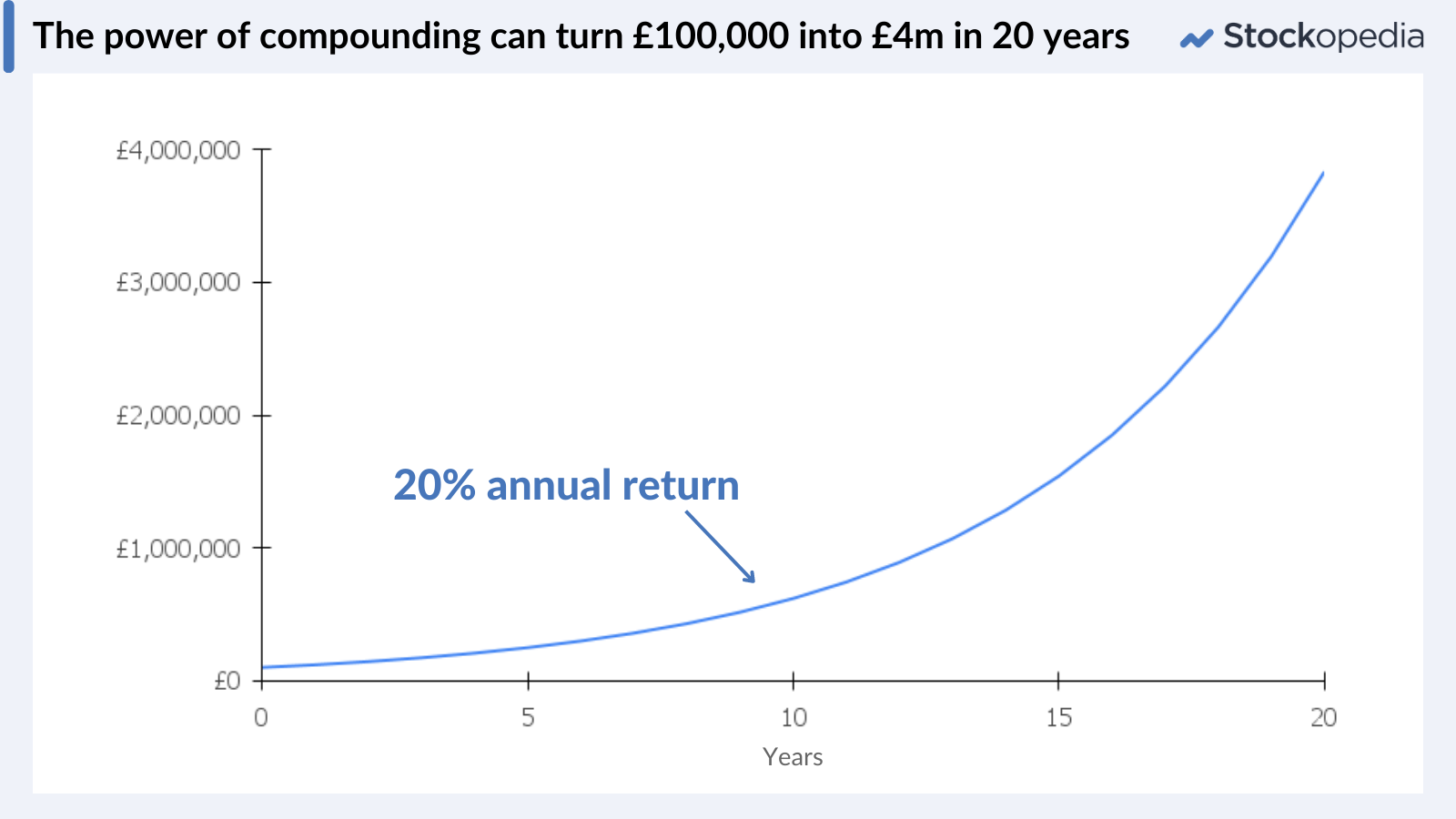
In this piece, I’m going to convert the ideas Megan discussed into a set of screening rules and build a screen to try and find quality compounders.
Getting started with screens
I’ve been using Stockopedia’s screening tools for many years, but I suffer occasional pangs of fear when faced with an empty screen; where do I start?
Over time, I’ve developed a strategy that allows me to build the screen I want by following a series of simple steps. I find that the best way to start is by making a short list of the characteristics I’m trying to capture.
In this case, I’ve used Megan’s Compounding Quality guide to create a short list of requirements:
Minimum size
High returns on capital employed
Strong profit margins
Good cash conversion
Consistent revenue growth
Low levels of gearing
Now it’s time to start creating the screen. Stockopedia allows you to store up to 20 in your account, so there’s plenty of scope for experimenting. To get started, choose Screens -> New Screen from the sitewide navigation bar:

You’ll now be presented with a blank screen that’s ready for you to start adding rules.
Note the screen always shows the number of stocks that qualify at the top of the list of results (circled). I tend to keep an eye on this as I add rules, so I can see the impact of each change.
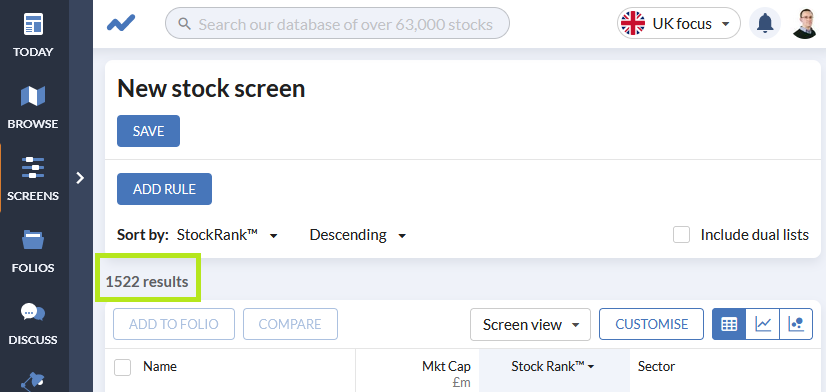
When you’re building a screen, the results list updates in real time. This makes it easy to see the impact of new rules and changes. Stockopedia’s screener is a really powerful tool, in my view – I couldn’t imagine investing without using screens.
Building the screen
For me, the first stage in any screen is defining my investable universe. Are there any stocks I won’t consider, under any circumstances?
In this case, I’m going to keep it simple with just two restrictions:
Market cap > £50m: Quality compounders are generally quite large companies. Anything smaller than £50m would need very careful research, in my view.
QualityRank >80: I’m looking for very high quality businesses. I think it would be counterproductive to consider shares that don’t score well with Stockopedia’s QualityRank algorithm, which is backed by academic research.
To get started, click Add Rule. We can see that the metrics we might want to choose are grouped logically down the left:
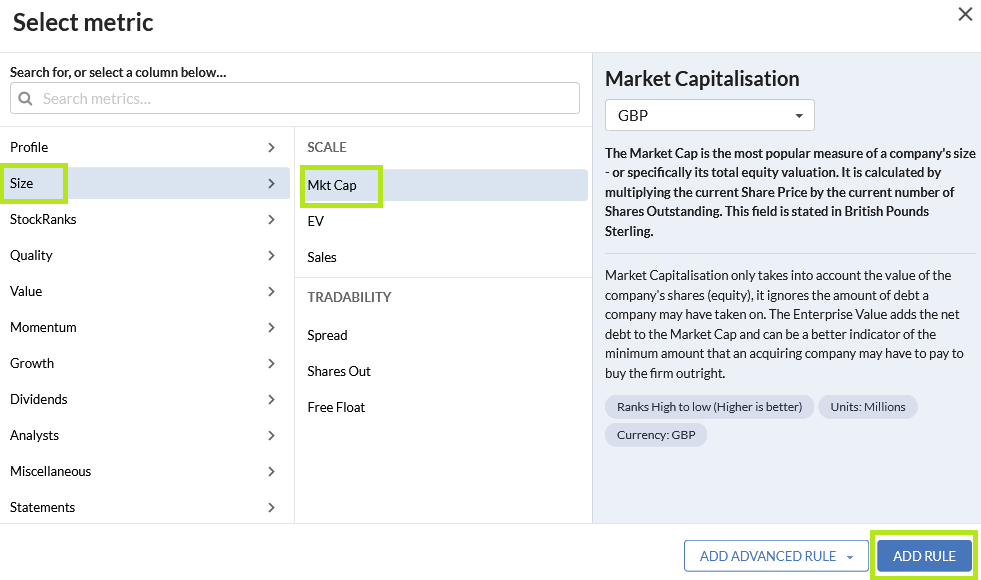
To specify a market cap rule, click on Size and then Mkt Cap – then click the Add Rule in the bottom right:
After this, choose the comparator you want to use from the drop-down list and then enter the value that’s needed.
This is how my market cap rule looks when I specify a minimum size of £50m:

We can see that just this one rule has reduced the number of results from more than 1,500 down to 874.
Adding a QualityRank rule reduces my selection to a more manageable 259 companies:

At this point, it might be a good idea to save your new screen (they can always be deleted or duplicated in the future). Hit save in the top right and enter a name – the screen will then appear on your list when you hover over the Screens icon on the navigation bar:
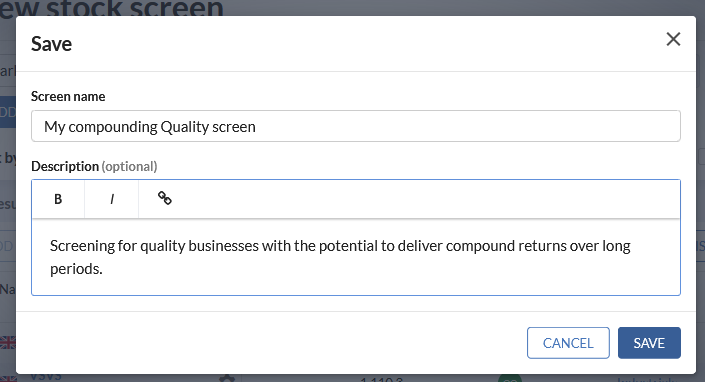
I’ll now begin to build the rules for this screen. For each one I’ll include details of the location and a screenshot of the finished rule.
Profitability
One thing that Terry Smith and Warren Buffett agree on is the importance of high returns on capital employed (ROCE). The reason for this is that over long periods, a company’s growth rate is limited by the returns it can earn on capital.
This also means that long-term share price performance is likely to be limited by ROCE.
To see what I mean, compare the Tesco (LON:TSCO) and Unilever (LON:ULVR) share prices over the last 20 years. Both were already large, mature companies in 2003. But look how they’ve performed since then:

I’m looking for stocks with consistently high ROCE. My target is a long-term average ROCE of at least 20%. But to allow a little wiggle room for year-on-year variations, I’ve created two rules with slightly lower ROCE values:
Long-term ROCE > 18%
Trailing 12-month (TTM) ROCE > 15%
ROCE can be found under Quality -> ROCE. We can then choose the timeframe using the drop down:
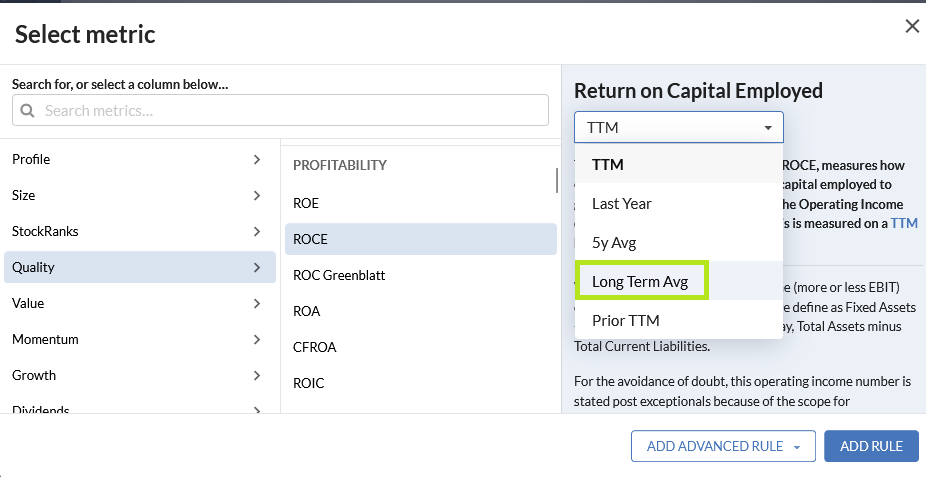
Profitability really is the key to quality. While ROCE is the primary metric I use, I also want companies with attractive profit margins. To do this, I’ve created a further four rules:
Operating margin 5y avg > 10%
Operating margin TTM > 10%
Net margin 5y avg > 8%
Net margin TTM > 8%
Operating margin and net margin are both listed under Quality in the screener. Here’s how the finished rules look:
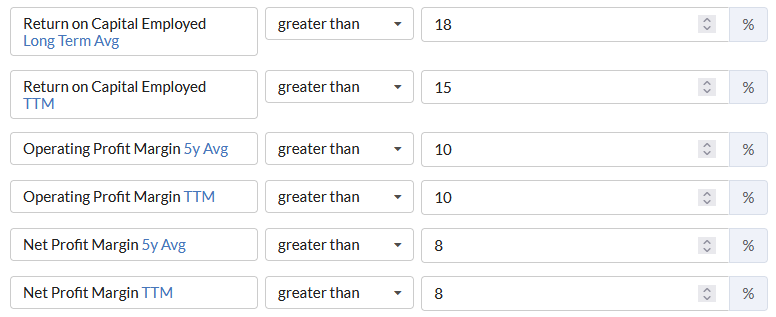
Cash conversion
A high-quality business will convert most of its profits into cash. Otherwise, it won’t be able to invest in growth or pay dividends without borrowing money – a classic warning sign of poor quality profits.
To test for cash conversion I’ve used two rules:
Operating cash flow per share / earnings per share TTM > 0.8: this compares a company’s operating cash flow with its accounting earnings.
A 1:1 ratio would mean that 100% of after-tax earnings were converted to cash. That’s ideal, but not always realistic on a year-to-year basis.
To avoid ruling out too many good stocks, I’ve specified an operating cash conversion ratio of 0.8x earnings.
This metric can be found under Statements -> OCF/EPS in the rule builder:

Long-term free cash flow/assets > 8%: this ratio looks at the surplus cash generated by a company’s assets. In my experience, this is another good test of cash generation.
I’ve opted for a figure of 8%. In the current market, I think that assets generating a cash yield of less than 8% per year are unlikely to be truly high quality. After all, you can get over 4% risk free.
In reality, many quality businesses generate much higher free cash flow yields from their assets; 15%-20% isn’t uncommon. But free cash flow can vary for legitimate reasons from year to year, so I don’t want to be too exclusive at this stage.
This metric can be found under Quality -> FCF LT/Assets in the rule builder:

Growth
Quality compounders are not generally fast growers. But almost without exception, they will deliver enough sales growth each year to keep pace with inflation.
The easiest way to measure this is to look at revenue growth. If a company’s revenue isn’t rising each year, then it’s almost certainly losing volume or seeing its pricing power weaken. If either of these things are happening, then it’s probably not a quality compounder.
For this screen I’ve used two rules – one to measure longer-term revenue growth and one to test for pricing power in the current inflationary environment:
Sales CAGR 5y > 0%: this rule looks for positive annualised sales growth over the last five years.
This metric can be found under Growth -> Sales CAGR with 5y specified in the drop-down box:

Sales TTM >1.05x Sales Prior TTM: this rule checks to see if a company’s revenue has risen by at least 5% over the last year. This is the bare minimum I think is needed right now for pricing to be keeping pace with inflation.
To create this rule, I’ve used the Advanced Rule option to specify a comparison:
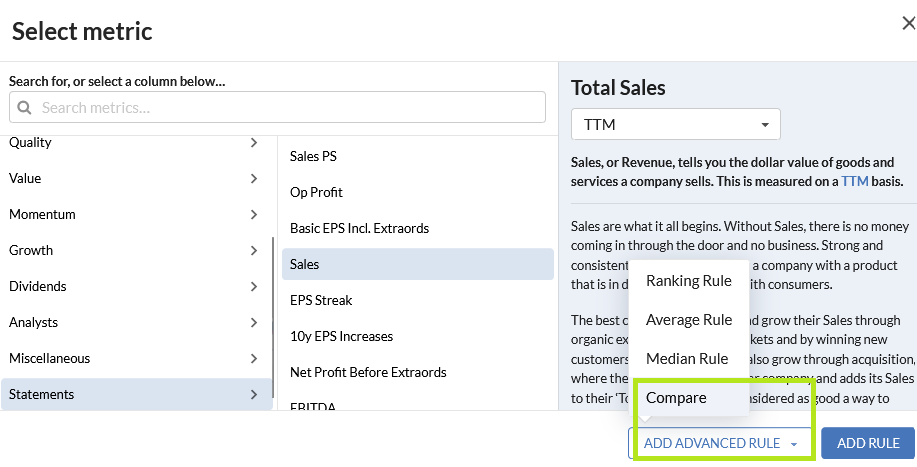
Here’s how the finished rule looks:

Debt & Gearing
Net gearing compares a company’s net debt with the balance sheet (book) value of its equity. I think it's a good general guide to leverage in a business, but it does have some weaknesses as a screening metric.
Factors such as large cash balances, lease commitments, and capital-light business models can all result in net gearing that may not be a true representation of the leverage being used to run the business.
For these reasons, I’ve opted to use two slightly different metrics to measure indebtedness:
Debt to assets < 50%: this ratio compares a company's total debt with the book value of its assets. It excludes cash.
Debt/assets is similar to the loan-to-value ratio on a mortgage. I think it’s a good measure of the structural leverage in a business.
This metric can be found under Quality -> Debt/Assets in the rule builder. Here’s how it looks:

Interest cover > 10x: this metric compares operating profit with interest costs over the last 12 months. It’s a test to see whether a company might have problems servicing its debts.
I’ve opted for a cover level of 10x to make sure I avoid companies that are spending more than 10% of their operating profit on interest payments. A business that spends a high proportion of its profits on debt service is unlikely to be compounding for shareholders, however profitable it might be.
Interest cover can be found under Quality in the rule builder:

Here’s a snapshot of the finished screen:

You can see (and copy) my compounding quality screen here.
At the time of writing, this screen generates 35 results. I’ve sorted them here by QualityRank:
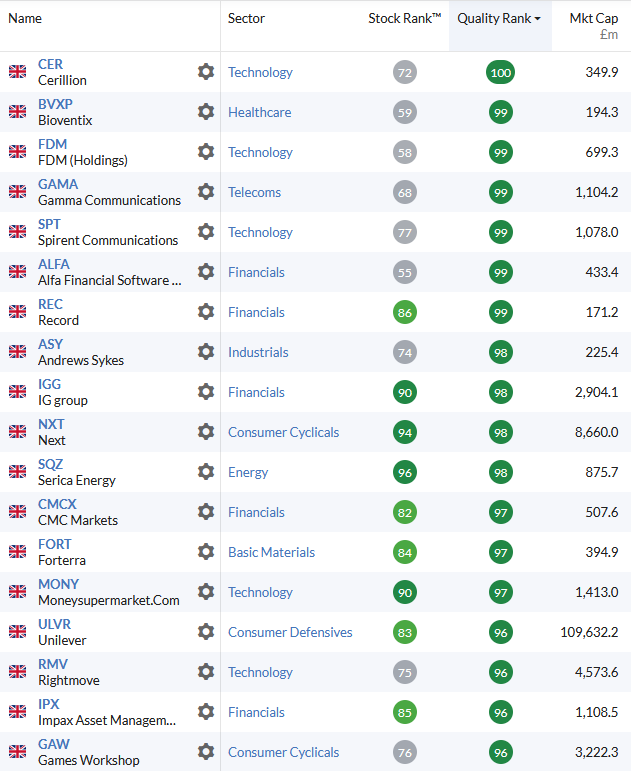
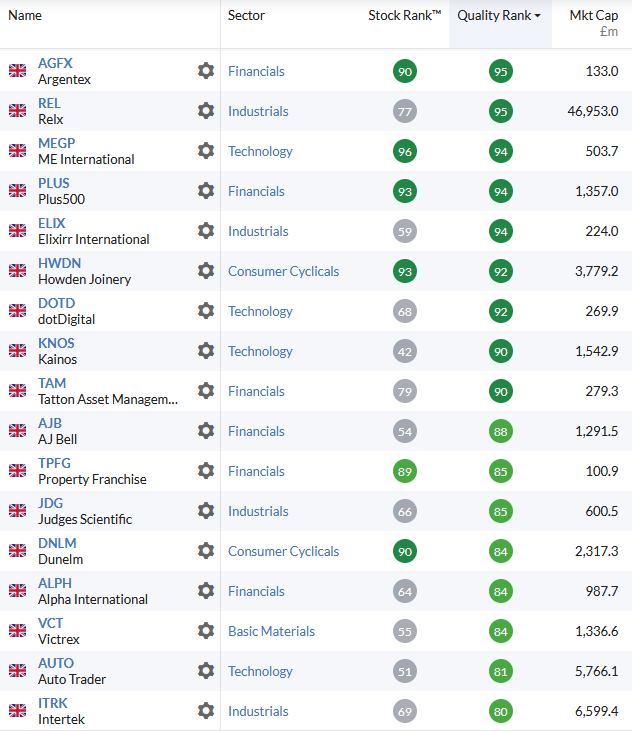
This list is only a basis for further research – not all of these stocks are quality compounders. But I’m quite happy with the results. I think there are definitely some stocks here with a track record of delivering compound returns and the potential to continue doing so.
What about valuation: is the price right?
You’ll notice that these screening rules do not include any criteria related to valuation (or momentum).
That’s deliberate. This screen is focused purely on quality. In this context, near-term earnings forecasts or valuation metrics are not especially important. Over long periods, a true compounder should deliver attractive returns from almost any entry point, within reason.
This method of investing requires careful research, commitment, and patience – and an ability to ride out difficult patches. It’s not for everyone, but history suggests it can be a powerful technique over long periods.
Disclosure: Roland owns shares of Unilever.

About Roland Head
I'm an investment writer and analyst, with a particular focus on systematic investing and dividends. I look for quality stocks with above-average returns, strong cash generation, and attractive valuations - always with dividends.
In my earlier life, I worked as an systems engineer in telecoms and IT. The quantitative, rules-based approach required for this kind of work suits me and has certainly influenced my investing style. I also learned a lot from seeing the tech bubble deflate in 2000/1, when I was working for a large and now defunct telecoms group.
Disclaimer - This is not financial advice. Our content is intended to be used and must be used for information and education purposes only. Please read our disclaimer and terms and conditions to understand our obligations.

Good article, I'm pleased to see that 4 of my holdings have made your quality compounding screen.

Thank you. An interesting article that will help me to narrow down my field of research

This is a really good article it has some similarities to the main screen I use. The key to this working is sticking to the plan and therefore not going off piste by something that isn't in the scan. In my experience anything speculative that doesn't meet the scan has either been a close escape or a total dud.
It was good to see a few I've invested in are in that list. Mine has a bit more risk compared to this one because I go for deeper value. The problem with going for deep value is the risk element because you have to look at their debt liabilities also the risk of them going bust, not only that from my experience I'd say the sell off on value shares in a correction is around double the decline in the main index like the FTSE (eg FTSE decline -10% your value shares decline -20%). So with my portfolio if I see a correction brewing I tend to increase cash then re-enter when the correction is over. You have to be more nimble with mine (but I'm it's something I'm used to).
Basically I use Quality > 70, Value > 85, Higher than 100 million market cap, Operating margin over 4%, health score over 5, Altman Z over 2, and any company that pays a dividend (not exceeding 10%). There's a few other metrics. That just gives you a list where you do further investigation.

An excellent screen. The only omission a filter that snares book value growth over the last 5 years. You'd want to see that operating leverage leads to capital reinvested in the business. I'd probably also add a filter on share dilution. However, a really well thought out screen. Head is one of the main reasons I still subscribe to Stocko. To add that Mark Simpson has suggested net margin can be initially low for compounders so I'd probably omit this filter.
*Past performance is no indicator of future performance. Performance returns are based on hypothetical scenarios and do not represent an actual investment.
This site cannot substitute for professional investment advice or independent factual verification. To use Stockopedia, you must accept our Terms of Use, Privacy and Disclaimer & FSG. All services are provided by Stockopedia Ltd, United Kingdom (company number 06367267). For Australian users: Stockopedia Ltd, ABN 39 757 874 670 is a Corporate Authorised Representative of Daylight Financial Group Pty Ltd ABN 77 633 984 773, AFSL 521404.


https://www.stockopedia.com/sc...
https://www.stockopedia.com/sc...
Will the screens above re-rate with the market any some time soon?
Usually the case!
If so will markets fall or Sreens outperform?